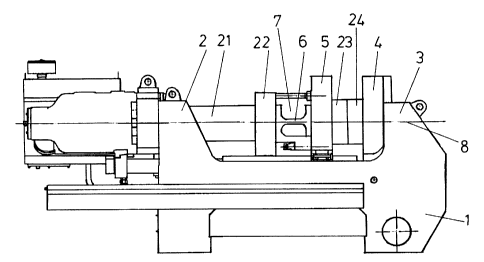Some of the information on this Web page has been provided by external sources. The Government of Canada is not responsible for the accuracy, reliability or currency of the information supplied by external sources. Users wishing to rely upon this information should consult directly with the source of the information. Content provided by external sources is not subject to official languages, privacy and accessibility requirements.
Any discrepancies in the text and image of the Claims and Abstract are due to differing posting times. Text of the Claims and Abstract are posted:
| (12) Patent: | (11) CA 2231678 |
|---|---|
| (54) English Title: | INJECTION MOLDING MACHINE |
| (54) French Title: | MACHINE A MOULER PAR INJECTION |
| Status: | Deemed expired |
| (51) International Patent Classification (IPC): |
|
|---|---|
| (72) Inventors : |
|
| (73) Owners : |
|
| (71) Applicants : |
|
| (74) Agent: | FETHERSTONHAUGH & CO. |
| (74) Associate agent: | |
| (45) Issued: | 2004-02-24 |
| (86) PCT Filing Date: | 1997-07-10 |
| (87) Open to Public Inspection: | 1998-01-22 |
| Examination requested: | 1999-07-07 |
| Availability of licence: | N/A |
| (25) Language of filing: | English |
| Patent Cooperation Treaty (PCT): | Yes |
|---|---|
| (86) PCT Filing Number: | PCT/AT1997/000160 |
| (87) International Publication Number: | WO1998/002291 |
| (85) National Entry: | 1998-03-11 |
| (30) Application Priority Data: | |||||||||
|---|---|---|---|---|---|---|---|---|---|
|
The invention relates to an injection moulding machine with a substantially C-
shaped machine frame with one leg on which a stationary
die platen is mounted and with another leg on which a closing mechanism for
driving a movable die platen is mounted. An articulated part
which comprises a girder extending in the longitudinal direction of the
machine is arranged between at least one die platen and the machine
frame and is deformed when a closing force is applied which tips the die
platen in relation to the associated leg of the machine frame. The
horizontal central axis (8) of the die platen, which axis (8) is determined by
centring means for the die extends completely inside the girder
(6) and the cross-section of the articulated part (7) increases in size in the
same direction, starting from the central girder (6).
Machine à mouler par injection comprenant un châssis en forme générale de "C", sur l'une des traverses duquel il est prévu, pour le moule, un plateau de fixation stationnaire et, sur l'autre traverse, un mécanisme de fermeture pour l'entraînement d'un plateau de fixation mobile. Entre au moins un plateau et le châssis est disposée une pièce articulée comprenant des branches s'étendant dans le sens longitudinal de la machine, cette pièce étant déformée lorsqu'une force de fermeture est appliquée, permettant ainsi au plateau de fixation de basculer par rapport à la traverse correspondante du châssis. L'axe horizontal (8) des plateaux de fixation, déterminé par les dispositifs de centrage du moule s'étend, dans sa totalité, à l'intérieur de la branche (6), et la section de la pièce articulée (7) s'agrandit dans le même sens, à partir de la branche centrale (6).
Note: Claims are shown in the official language in which they were submitted.
Note: Descriptions are shown in the official language in which they were submitted.

For a clearer understanding of the status of the application/patent presented on this page, the site Disclaimer , as well as the definitions for Patent , Administrative Status , Maintenance Fee and Payment History should be consulted.
| Title | Date |
|---|---|
| Forecasted Issue Date | 2004-02-24 |
| (86) PCT Filing Date | 1997-07-10 |
| (87) PCT Publication Date | 1998-01-22 |
| (85) National Entry | 1998-03-11 |
| Examination Requested | 1999-07-07 |
| (45) Issued | 2004-02-24 |
| Deemed Expired | 2010-07-12 |
There is no abandonment history.
| Fee Type | Anniversary Year | Due Date | Amount Paid | Paid Date |
|---|---|---|---|---|
| Registration of a document - section 124 | $100.00 | 1998-03-11 | ||
| Application Fee | $300.00 | 1998-03-11 | ||
| Maintenance Fee - Application - New Act | 2 | 1999-07-12 | $100.00 | 1999-07-06 |
| Request for Examination | $400.00 | 1999-07-07 | ||
| Maintenance Fee - Application - New Act | 3 | 2000-07-10 | $100.00 | 2000-07-05 |
| Maintenance Fee - Application - New Act | 4 | 2001-07-10 | $100.00 | 2001-06-28 |
| Maintenance Fee - Application - New Act | 5 | 2002-07-10 | $150.00 | 2002-06-25 |
| Maintenance Fee - Application - New Act | 6 | 2003-07-10 | $150.00 | 2003-07-04 |
| Final Fee | $300.00 | 2003-12-16 | ||
| Maintenance Fee - Patent - New Act | 7 | 2004-07-12 | $200.00 | 2004-07-05 |
| Maintenance Fee - Patent - New Act | 8 | 2005-07-11 | $200.00 | 2005-06-29 |
| Maintenance Fee - Patent - New Act | 9 | 2006-07-10 | $200.00 | 2006-06-27 |
| Maintenance Fee - Patent - New Act | 10 | 2007-07-10 | $250.00 | 2007-06-21 |
| Maintenance Fee - Patent - New Act | 11 | 2008-07-10 | $250.00 | 2008-06-30 |
Note: Records showing the ownership history in alphabetical order.
| Current Owners on Record |
|---|
| ENGEL MASCHINENBAU GESELLSCHAFT MBH |
| Past Owners on Record |
|---|
| URBANEK, OTTO |
| WIMBAUER, GERHARD |